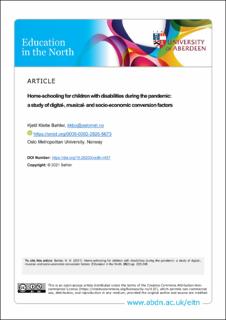| dc.contributor.author | Bøhler, Kjetil Klette | |
| dc.date.accessioned | 2022-03-25T15:40:47Z | |
| dc.date.available | 2022-03-25T15:40:47Z | |
| dc.date.created | 2022-01-25T14:14:11Z | |
| dc.date.issued | 2021 | |
| dc.identifier.citation | Education In The North. 2021, 28 (3), 221-248. | en_US |
| dc.identifier.issn | 0424-5512 | |
| dc.identifier.uri | https://hdl.handle.net/11250/2987745 | |
| dc.description.abstract | This article investigates how increased focus on home-schooling influenced children with disabilities´ everyday education during the pandemic. Specifically, I focus on how children with disabilities were able to engage in home-schooling on digital learning platforms according to their own interests during the pandemic. Conceptually I draw on theoretical arguments developed within the ‘capability approach’ with a particular emphasis on “conversion factors” as this model allows me to identify the different mechanisms that may hamper, and/or enable, children with disabilities´ learning practices. I pay specific attention to what I call digital-, musical- and socio-economic conversion factors, and describe how these three contexts (musical practices, digital platforms and socio-economic background coupled with ethnicity) influenced the children’s educational experience. Three lessons can be learned. First, socioeconomic and ethnic backgrounds became even more consequential during the pandemic, as many children with disabilities were left more on their own and offered less support from educational institutions and the welfare services due to various infection-control measures. This placed single mothers and parents with few resources and/or immigrant backgrounds in a particularly vulnerable position as they struggled to make the ends meet while absorbing all of the new responsibilities of home-schooling. Second, many people experienced the new virtual classroom as chaotic, which marginalised children with disabilities who had trouble handling online social codes, either on teaching and learning platforms or through social media. Third, musical practices represented an important part of some children’s everyday education which parents discovered anew during the pandemic. Music facilitated learning while simultaneously contributing to a sense of well-being and social participation for their children. More work is needed on how musical practices, digital technologies, and socio-economic features may hamper and facilitate the educational experience of persons with disabilities. | en_US |
| dc.language.iso | eng | en_US |
| dc.publisher | University of Aberdeen | en_US |
| dc.relation.ispartofseries | Education In The North;Volume 28 (3): Nordic values and schooling during COVID-19: how to balance comprehensive education and sustainable pandemic regulations | |
| dc.rights | Navngivelse-Ikkekommersiell 4.0 Internasjonal | * |
| dc.rights.uri | http://creativecommons.org/licenses/by-nc/4.0/deed.no | * |
| dc.subject | Music | en_US |
| dc.subject | Disabled children | en_US |
| dc.subject | Education | en_US |
| dc.subject | Capability | en_US |
| dc.subject | Conversion factors | en_US |
| dc.title | Home-schooling for children with disabilities during the pandemic : a study of digital-, musical- and socio-economic conversion factors | en_US |
| dc.type | Peer reviewed | en_US |
| dc.type | Journal article | en_US |
| dc.description.version | publishedVersion | en_US |
| dc.rights.holder | © 2021 Bøhler | en_US |
| cristin.ispublished | true | |
| cristin.fulltext | original | |
| cristin.qualitycode | 1 | |
| dc.identifier.doi | https://doi.org/10.26203/xxdb-n437 | |
| dc.identifier.cristin | 1989588 | |
| dc.source.journal | Education In The North | en_US |
| dc.source.volume | 28 | en_US |
| dc.source.issue | 3 | en_US |
| dc.source.pagenumber | 221-248 | en_US |

